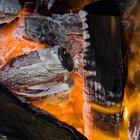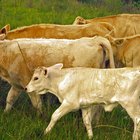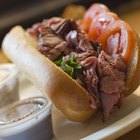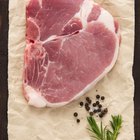Frozenmost/iStock/GettyImages
Your oven does a fine job of cooking large roasts, but it can't match the rich flavor of a roast cooked at an open fire. If you don't have a charcoal kettle or barbecue pit at your disposal, you can use an open fire to cook roasts such as prime rib. It's easiest if you have a rotisserie spit to turn the roast, so it cooks evenly, but all you really need is a campfire and some patience.
Spit Method
Trim away any excess fat from the roast's surface. Season the roast all over with salt and pepper, or use a dry spice rub or paste if you prefer. Rest the seasoned roast for at least an hour or two, and preferably overnight if possible.
Arrange a firepit with a line of stones or large logs on either side to trap some of the fire's heat. Keep one end narrow enough to fit a wire rack, and build a fire of dry hardwoods or charcoal at the other end. Let it burn down to coals, then rake the bed of coals to the middle. Keep a few fresh pieces of wood at the back of the fire to replenish your bed of coals as you cook.
Slide a pan under the rack to catch drips from the roast, then position the prime rib over it. It should be far enough from the coals to only receive indirect heat, but close enough for the meat to cook gently. if your roast is sizzling and beginning to brown after 30 minutes, move it farther away. If it isn't visibly cooking, move it closer.
Slow-roast the beef in the indirect heat of your fire for 4 to 6 hours, depending on the size of the roast, until its internal temperature reaches 115 degrees Fahrenheit when tested with an instant-read thermometer. Turn the beef every 20 to 30 minutes during this cooking time, to ensure it cooks evenly.
Using a pair of long tongs, move the roast to the high-heat area over the coals. Finish it in the searing heat, turning it to brown the outside deeply. Remove the roast from the fire, and let it rest for 10 to 15 minutes before carving. The final temperature should be 130 F for medium rare, or higher if you prefer your beef more done.
Rotisserie Roasting
Season the prime rib roast with your favorite spice paste or dry rub, and refrigerate it overnight.
Build a fire of hardwoods or charcoal, taking care to remove any flammable materials from the immediate area. Let the fire burn down to coals, keeping a supply of additional firewood or charcoal nearby to replenish the coals from the back as needed.
Find the roast's center of balance by turning it in your hands a few times, then skewer it with the spit. Use the rotisserie's secondary forks or prongs to fix the beef in place, and rotate the spit a few times to check the balance. Adjust the roast's position if necessary.
Position the rotisserie roughly 18 to 24 inches in front of the coals, then lock the spit into the rotisserie frame. If it has an electric motor, plug in the motor and turn it on. If it's a manual model, start turning the crank slowly and make sure you have lots of helpers lined up to take a turn. Place a pan under the roast to catch drips.
Slow-roast the prime rib for 4 to 6 hours, or until it reaches your preferred degree of doneness. A large roast will continue to cook for several minutes after it comes off the spit, so take it from the heat when the internal temperature is still 10 degrees below the doneness you want.
Related Articles

How to Cook a Beef Roast Over an Open ...
How to Cook a Standing Rib Roast on a ...

How to Smoke a Brisket With an Offset ...

How to Barbecue Roast Beef
How to Cook Prime Rib on an Electric ...

How to Smoke a Sirloin Tip Roast
How to Cook With a Reverse Flow Smoker

How to Slow Cook a Rolled Rib of Beef

How to Use an Offset Smoker to Cook a ...

How to Grill a Ribeye on a Weber Q

How to Cook Prime Rib Using an Oven ...

How Do I Cook a Hot Dog on a Fire?

How to Broil Filet Mignon Wrapped in ...

How to Cook a Brisket in the Ground
How to Cook a Center Cut Sirloin of ...

How to Cook Roast Beef in a Baby George ...
How to Cook a Spencer Roast

How to Cook Barbecue Boneless Pork Loin

How to Cook a Thresher Shark Steak

Grilling Instructions for Rib-Eye Steak
References
- On Food and Cooking: The Science and Lore of the Kitchen; Harold McGee
- Amazing Ribs: Secrets Of Prime Rib And Other Beef Roasts
- The Wall Street Journal: Charred to Perfection -- In Your Fireplace
Tips
- If the ribs feel loose and wobbly before you cook the beef, tie them tightly to the roast with butcher's twine. Alternatively, for easier cooking and carving, trim off the ribs to create a boneless ribeye. Tie it tightly with twine to give it a cylindrical shape, so it cooks evenly. Slow-cook the ribs separately, either at the same meal or for a second meal.
- The drippings in the pan under your roast make a wonderful jus to serve with the beef. Pour them into a narrow measuring cup and ladle off the fat as it rises to the surface, then serve the intensely flavored juices on the side.
- Roasting prime rib over an open fire is much like cooking one in your charcoal kettle, though it takes longer because there's no lid to trap the heat.
- If you have a traditional indoor fireplace, many companies manufacture rotisserie spits that fit neatly on your hearth. This is ideal for roasting your beef in inclement weather.
Writer Bio
Fred Decker is a trained chef and prolific freelance writer. In previous careers, he sold insurance and mutual funds, and was a longtime retailer. He was educated at Memorial University of Newfoundland and the Northern Alberta Institute of Technology. His articles have appeared on numerous home and garden sites including GoneOutdoors, TheNest and eHow.